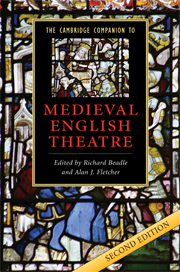Book contents
- Frontmatter
- 1 An introduction to medieval English theatre
- 2 The theatricality of medieval English plays
- 3 The cultural work of early drama
- 4 The York Corpus Christi Play
- 5 The Chester cycle
- 6 The Towneley pageants
- 7 The N-Town plays
- 8 The non-cycle plays and the East Anglian tradition
- 9 Morality plays
- 10 Saints and miracles
- 11 Modern productions of medieval English drama
- 12 A guide to criticism of medieval English theatre
- Select bibliography
- Author index to the bibliography
- General index
10 - Saints and miracles
Published online by Cambridge University Press: 28 November 2011
- Frontmatter
- 1 An introduction to medieval English theatre
- 2 The theatricality of medieval English plays
- 3 The cultural work of early drama
- 4 The York Corpus Christi Play
- 5 The Chester cycle
- 6 The Towneley pageants
- 7 The N-Town plays
- 8 The non-cycle plays and the East Anglian tradition
- 9 Morality plays
- 10 Saints and miracles
- 11 Modern productions of medieval English drama
- 12 A guide to criticism of medieval English theatre
- Select bibliography
- Author index to the bibliography
- General index
Summary
Among the genres of early dramatic writing, the saint's play is paradoxically both one of the most interesting and circumscribed. Part of its interest resides in its bifurcated focus, suggested by Mary del Villar's definition of the genre as, ‘a play that has a saint as its protagonist or a miracle as its main action’ (393, p. 84). Its dramatisation of the lives (or aspects of lives) of saints, makes it one of the last manifestations of a once strong and mostly non-dramatic tradition of hagiographical literature, and provides models for later theatrical writing that focus on exemplary biography. Its other principal feature, the staging of miracle, though sometimes effected through performance alone, often involves quite remarkable stage technology that endows this genre of drama with considerable interest for historians of early stage practice. The description of the genre as circumscribed simply reflects the fact that there are few examples of it extant, as the Reformation put a full stop to plays that dramatised the lives of recognised saints, though the tradition can be seen as continuing in the dramatic representations of other biblical figures in similar terms, as in Godly Queen Hester (1525–9) and Thomas Garter's Virtuous and Godly Susanna (1563–9).
It is subject matter rather than form that defines this particular category as it embraces a range of early dramatic forms, from liturgical drama to moral interlude. In the course of this discussion an attempt will be made to discern what common ground there is in this drama that might help to establish an idea of the genre, and a number of characteristic preoccupations will be identified and discussed, but these are based on the small number of extant plays and can only have conjectural application to the genre as a whole.
- Type
- Chapter
- Information
- The Cambridge Companion to Medieval English Theatre , pp. 263 - 286Publisher: Cambridge University PressPrint publication year: 2008
- 1
- Cited by

